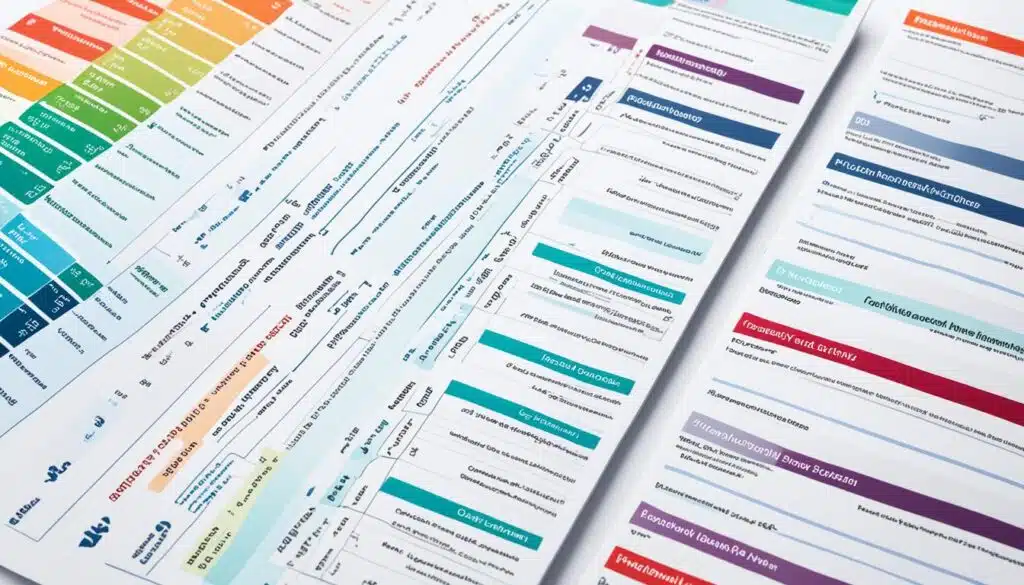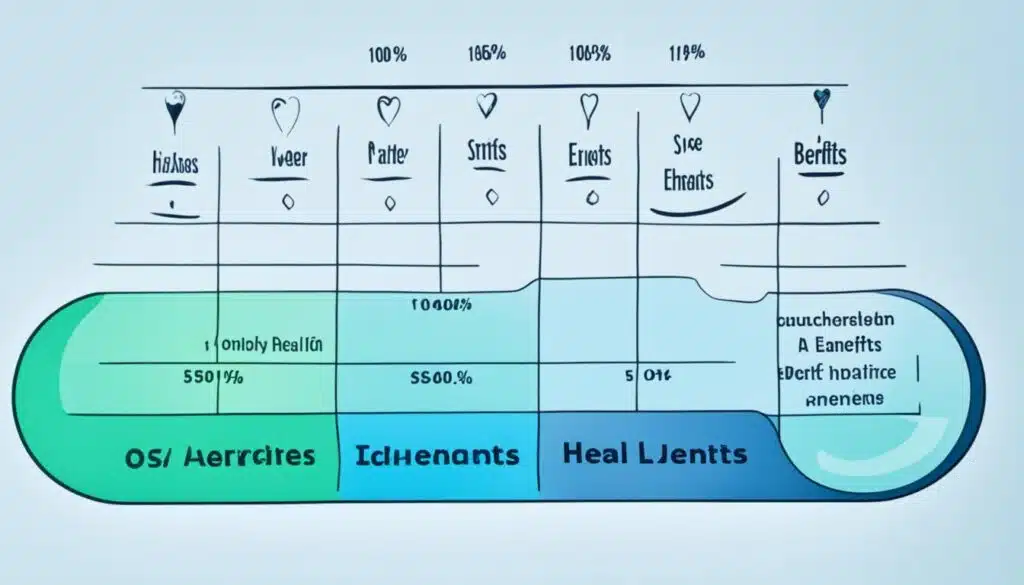Welcome to our comprehensive guide on health insurance plans. In this article, we will walk you through the process of choosing the right plan for your needs, helping you make informed decisions about your healthcare coverage. Whether you’re considering employer-sponsored plans, government insurance exchanges, or private exchanges, we’ve got you covered.
When it comes to health insurance, navigating through the various options can be overwhelming. That’s why it’s essential to understand the different types of plans available, such as Health Maintenance Organizations (HMOs), Preferred Provider Organizations (PPOs), Exclusive Provider Organizations (EPOs), and Point of Service (POS) plans. Each plan has its own set of benefits and limitations, including out-of-pocket costs, in-network providers, and referral requirements.
Throughout this guide, we’ll also explore how to weigh your family’s medical needs, considering factors such as past treatment trends and the preference for a referral system of care. We’ll discuss the benefits of High-Deductible Health Plans (HDHPs) and Health Savings Accounts (HSAs) for those looking to manage healthcare expenses.
Additionally, we’ll delve into the importance of evaluating health plan networks and understanding the cost implications of staying in-network versus going out-of-network. We’ll discuss the scope of services covered by different plans, including physical therapy, fertility treatments, mental health care, and emergency coverage.
Life events can also impact your health insurance needs, which is why we’ll walk you through the importance of open enrollment periods and provide guidance on navigating individual insurance plans. Lastly, we’ll delve into the benefits of utilizing a Health Savings Account (HSA) or Flexible Spending Account (FSA) to help cover eligible healthcare expenses.
Key Takeaways:
- Consider your healthcare needs and budget when choosing a health insurance plan.
- Evaluate different plan options, including employer-sponsored plans and government exchanges.
- Compare network coverage and provider options to ensure access to the care you need.
- Weigh the trade-offs between higher premium costs and lower out-of-pocket expenses.
- Review plan benefits, including coverage for essential services and specialty care.
Choose Your Health Insurance Marketplace
When it comes to health insurance plans, there are various avenues to explore. Finding the right fit for your needs requires careful consideration of the available options. Let’s take a closer look at the different health insurance marketplaces that can help you secure the coverage you require.
Employer-Sponsored Plans
Many individuals have access to health insurance through their employers. Employer-sponsored plans are a popular choice as they often offer comprehensive coverage at a competitive cost. These plans are provided by companies to their employees as part of their employee benefits package. It’s important to review the details of the plan offered by your employer to ensure it meets your healthcare needs.
Government Insurance Exchanges
The introduction of government insurance exchanges has provided individuals with another avenue to explore for health insurance coverage. These exchanges, also known as state marketplaces or federal marketplaces, offer a range of insurance options. Through these exchanges, individuals can compare different plans and select the one that best suits their needs and budget.
Private Exchanges
In addition to employer-sponsored plans and government insurance exchanges, there are also private exchanges that offer health insurance coverage. These exchanges are typically operated by private entities and provide a marketplace where individuals can browse and select from a range of plans offered by various insurance companies. Private exchanges offer flexibility and choice, allowing individuals to tailor their coverage to their specific needs.
It’s important to note that for eligible individuals, premium tax credits may be available when obtaining health insurance through government insurance exchanges. These tax credits can help lower the cost of premiums, making coverage more affordable.
By evaluating the options available through different marketplaces, you can make an informed decision regarding your health insurance plan. Consider factors such as cost, coverage, and provider networks to ensure you choose a plan that meets your needs. Being proactive about your health insurance will help you navigate the healthcare landscape with confidence.
Compare Types of Health Insurance Plans
When selecting a health insurance plan, it’s important to understand the different types available and how they can meet your specific needs. Here, we’ll compare the most common types of health insurance plans: HMO, PPO, EPO, and POS.
HMO (Health Maintenance Organization)
HMO plans generally offer lower out-of-pocket costs and require you to choose a primary care physician (PCP) from a network of healthcare providers. Your PCP will coordinate your healthcare needs and refer you to specialists within the network. Should you need care outside of the network, it may not be covered by your plan.
PPO (Preferred Provider Organization)
PPO plans provide more flexibility in choosing healthcare providers. You can see both in-network and out-of-network providers without requiring a referral from a PCP. While in-network services will have lower out-of-pocket costs, you do have the option to visit out-of-network providers, albeit at a higher cost.
EPO (Exclusive Provider Organization)
EPO plans are similar to HMOs in that they require you to stay in-network for coverage. However, EPO plans do not typically require referrals, allowing you to see specialists without going through a PCP. If you seek care outside of the network, it will generally not be covered.
POS (Point of Service)
POS plans combine aspects of both HMOs and PPOs. You will need to choose a PCP within the network and obtain referrals for specialist care. However, you also have the option to see providers outside of the network, although at a higher out-of-pocket cost.
When comparing these plans, consider your specific healthcare needs, budget, and provider preferences. Evaluate the out-of-pocket costs, in-network coverage options, referral requirements, and provider networks for each plan. This will help ensure you choose a health insurance plan that best meets your needs and provides access to the care you require.
| Plan Type | Out-of-Pocket Costs | In-Network Coverage | Referrals | Primary Care Physician | Provider Options |
|---|---|---|---|---|---|
| HMO | Lower | Limited to network | Required | Yes | Network providers only |
| PPO | Varies | In-network preferred | Not required | No | Both in-network and out-of-network providers |
| EPO | Lower | Limited to network | Not required | No | Network providers only |
| POS | Varies | In-network preferred | Required | Yes | Both in-network and out-of-network providers |
Weigh Your Family’s Medical Needs
When choosing a health insurance plan, it is important to consider your family’s unique medical needs. By assessing past treatment trends and understanding your preferred referral system of care, you can make an informed decision that aligns with your family’s healthcare requirements.
Medical needs can vary greatly from one family to another. While some families may require frequent specialist visits or ongoing treatments, others may have more routine healthcare needs. By evaluating your family’s medical history and considering any ongoing conditions or potential future medical needs, you can choose a plan that provides adequate coverage.
One factor to consider when assessing medical needs is the referral system of care. Certain health insurance plans, such as HMOs (Health Maintenance Organizations) and POS (Point of Service) plans, require patients to obtain referrals from their primary care physician before seeing a specialist. This referral system ensures that patients receive coordinated and appropriate care, but it may add an additional step in accessing specialty care.
Alternatively, other plans such as PPOs (Preferred Provider Organizations) and EPOs (Exclusive Provider Organizations) do not typically require referrals and offer more flexibility in choosing providers. Understanding your preferences for a referral system can help you determine which type of plan aligns best with your family’s medical needs.
Moreover, it is worth considering the benefits and potential cost savings associated with a high-deductible health plan (HDHP) paired with a health savings account (HSA). HDHPs typically have lower premiums but require higher out-of-pocket costs before reaching the deductible. However, they can be advantageous for individuals or families with lower medical needs who want to save on monthly premiums while still having coverage for catastrophic events.
An HSA is a tax-advantaged savings account that can be used to pay for qualified medical expenses. Contributions to an HSA are made with pre-tax dollars, reducing your taxable income, and any unused funds can roll over from year to year. This can be especially beneficial for families with predictable healthcare expenses as they can save money tax-free for future medical needs.
| Plan Type | Referral System | Key Features |
|---|---|---|
| HMO (Health Maintenance Organization) | Requires referrals from a primary care physician | – Network restrictions |
| POS (Point of Service) | Requires referrals from a primary care physician | – More flexibility in choosing providers than HMOs |
| PPO (Preferred Provider Organization) | No referrals required | – Larger network of providers |
| EPO (Exclusive Provider Organization) | No referrals required | – Network restrictions |
| HDHP (High-Deductible Health Plan) with HSA (Health Savings Account) | No referrals required | – Lower premiums, higher out-of-pocket costs |
By weighing your family’s medical needs, considering past trends in treatment, evaluating your preference for a referral system, and exploring the benefits of an HDHP with an HSA, you can make a well-informed decision when choosing a health insurance plan that provides the right fit for your family’s healthcare needs.
Compare Health Plan Networks
When selecting a health insurance plan, it’s essential to carefully evaluate the health insurance network. The network refers to the group of healthcare providers, doctors, hospitals, and specialists that your insurance plan has contracts with to provide medical services at discounted rates to plan members. Understanding the network structure is crucial because it can significantly impact the cost of your care.
Staying in-network is generally more cost-effective as these providers have negotiated lower rates with the insurance company. When you receive medical services from an in-network provider, your insurer covers a significant portion of the costs, reducing your out-of-pocket expenses. It’s important to note that health insurance plans typically have different tiers of coverage for in-network providers, so be sure to understand the specific benefits and cost-sharing arrangement of your plan.
Preferred providers, sometimes referred to as preferred doctors, are those in-network providers with whom your insurance plan has a stronger affiliation. By opting for preferred doctors, you can maximize the value of your insurance coverage and potentially enjoy additional perks or incentives, such as lower copayments or a streamlined appointment process.
One advantage of choosing a health insurance plan with a large network is the wider choice of providers and facilities. A large network offers more options for primary care physicians, specialists, hospitals, and clinics. This flexibility can be particularly beneficial if you have specific healthcare needs or prefer to see a particular doctor or specialist.
Living in a rural community presents unique challenges when it comes to access to healthcare services. For individuals residing in rural areas, having a health insurance plan with an extensive network becomes even more important. A large network ensures that you have sufficient coverage options, including providers and facilities close to your home, reducing the need for long-distance travel.
| Benefits of Evaluating Health Plan Networks |
|---|
| Lower out-of-pocket costs for in-network providers |
| Access to preferred doctors and additional perks |
| Choice and flexibility with a large network |
| Enhanced coverage options for individuals in rural communities |
By carefully assessing the health plan network, you can ensure that your insurance coverage aligns with your healthcare needs and budget. Remember to check if your preferred doctors are in-network and research the availability of hospitals, clinics, and specialists in your area. Doing so will provide peace of mind and help you make an informed decision when selecting a health insurance plan.
Compare Out-of-Pocket Costs
When it comes to health insurance plans, understanding out-of-pocket costs is crucial. These costs refer to the expenses you pay directly, beyond your monthly premiums, to receive healthcare services. Let’s break down the different components of out-of-pocket costs:
Premiums
Premiums are the fixed amount you pay each month to maintain your health insurance coverage. They are not considered as out-of-pocket costs since they are paid regardless of whether you use healthcare services or not.
Copayments
Copayments, or copays, are a predetermined fee you pay at the time of receiving specific medical services. For example, you might have a $25 copayment for each visit to your primary care physician or a $50 copayment for each specialist visit.
Coinsurance
Coinsurance is the percentage of the cost you are responsible for paying after you’ve met your deductible. For instance, if you have a 20% coinsurance rate, you would pay 20% of the allowed amount for a particular service, while your insurance would cover the remaining 80%.
Deductible
A deductible is the amount you must pay out of pocket before your insurance coverage kicks in. For instance, if you have a $1,000 deductible, you’ll need to cover $1,000 of healthcare expenses before your insurance starts paying for covered services.
Out-of-Pocket Maximum
The out-of-pocket maximum is the maximum amount you have to pay in a year for covered medical expenses. Once you reach this limit, your insurance should cover 100% of your covered medical costs for the remainder of the year.
Understanding each of these components and how they work together can help you make informed decisions about your health insurance plan. Keep in mind that plans with higher premiums typically have lower out-of-pocket costs, while plans with lower premiums often come with higher out-of-pocket costs.
To further illustrate the impact of out-of-pocket costs, consider the following example:
John has two health insurance plan options: Plan A with a $200 monthly premium and a $2,000 deductible, and Plan B with a $400 monthly premium and a $1,000 deductible. Both plans have a 20% coinsurance rate and a $5,000 out-of-pocket maximum.
If John chooses Plan A, his monthly premium is lower, but he will need to pay a higher deductible before his insurance coverage starts. On the other hand, if John chooses Plan B, his monthly premium is higher, but he will have a lower deductible. The choice depends on John’s anticipated healthcare needs and budget considerations.
It’s important to carefully evaluate the out-of-pocket costs and weigh them against your anticipated healthcare needs. By doing so, you can choose a health insurance plan that strikes the right balance for your financial situation and healthcare requirements.
Compare Plan Benefits
When it comes to choosing a health insurance plan, it’s crucial to carefully review the plan benefits to ensure they align with your specific healthcare needs. Understanding the scope of services and coverage provided can help you make an informed decision that suits your requirements.
Physical Therapy
One important aspect to consider is the coverage for physical therapy. If you or a family member require ongoing physical rehabilitation, it’s essential to choose a plan that includes comprehensive physical therapy benefits. This ensures you have access to the necessary sessions and treatments to aid in your recovery.
Fertility Treatments
For individuals or couples seeking fertility treatments, it’s essential to choose a plan that offers coverage for such services. Fertility treatments can be complex and expensive, so having this coverage can alleviate some of the financial burden associated with these procedures. It’s important to review the details of the coverage, including any restrictions or limitations.
Mental Health Care
Mental health care is a critical component of overall well-being, and it should be a consideration when comparing health insurance plans. Look for plans that provide comprehensive coverage for mental health services, including therapy and counseling. Having access to mental health care can greatly contribute to your overall health and quality of life.
Emergency Coverage
Emergency situations can happen unexpectedly, and it’s important to have adequate coverage in those times of need. When comparing plans, check whether emergency coverage is included and the extent of that coverage. Ensuring that emergency room visits and hospital stays are covered can provide peace of mind, knowing that you won’t face exorbitant medical bills in times of crisis.
“Choosing a health insurance plan with the right benefits can make all the difference when it comes to accessing the care you need. Take the time to review and compare plan benefits to ensure you’re making a well-informed decision.”
By carefully considering the plan benefits, including coverage for physical therapy, fertility treatments, mental health care, and emergency situations, you can select a health insurance plan that meets your specific needs. Don’t underestimate the importance of reviewing these benefits to ensure you’re adequately protected.
Consider Life Events and Open Enrollment
Open enrollment periods provide a valuable opportunity to reassess your insurance plan and make any necessary changes to ensure it aligns with your family’s evolving needs. Life events such as marriage, divorce, the birth or adoption of a child, or changes in employment status can significantly impact your coverage requirements. It’s crucial to take advantage of open enrollment to evaluate your options and make informed decisions.
Changing insurance plans during open enrollment allows you to consider individual insurance plans that cater to your specific needs. These plans offer a wide range of coverage options, including different metal categories that determine the balance between your premium costs and out-of-pocket expenses.
For those looking for more comprehensive coverage, individual insurance plans in higher metal categories such as gold and platinum may be suitable. These categories generally have higher premiums but offer lower out-of-pocket costs, making them ideal for individuals or families with higher healthcare needs or chronic conditions.
On the other hand, if you’re generally healthy and don’t anticipate needing frequent medical care, you may opt for individual insurance plans in lower metal categories such as bronze or catastrophic plans. These plans typically have lower premiums but higher out-of-pocket costs, making them more cost-effective for individuals who rarely need medical services but still want coverage for unexpected emergencies.
Open Enrollment
Open enrollment is an annual period during which individuals can enroll in or change their insurance plans. This period is typically provided by employers or government exchanges and is an essential opportunity to reassess your coverage options. It’s crucial to familiarize yourself with the specific dates and requirements for open enrollment to ensure you don’t miss out on this chance to tailor your health insurance plan.
Family Needs
Life events, such as starting a family or changes in your family’s health status, can significantly impact the type of coverage you need. When considering insurance plans during open enrollment, take into account your family’s specific healthcare needs. Ensure the plan you select adequately covers services such as preventive care, maternity care, pediatric care, and any specialists or prescription medications your family requires.
Coverage Options
During open enrollment, it’s important to familiarize yourself with the various coverage options available to you. Research the different metal categories of individual insurance plans and determine which one aligns best with your specific needs and budget. Consider your family’s overall health, anticipated medical expenses, and financial capabilities when evaluating coverage options.
Changing Insurance Plans
If you decide to change your insurance plan during open enrollment, ensure a smooth transition by carefully assessing the benefits and coverage details of the new plan. Compare the network of healthcare providers, prescription drug coverage, and any additional benefits that are important to you and your family.
Remember to review the out-of-pocket costs associated with the new plan, including deductibles, copayments, and coinsurance. Understanding these costs enables you to make a well-informed decision that balances affordability and coverage.
| Metal Category | Monthly Premium | Out-of-Pocket Costs | Benefits |
|---|---|---|---|
| Bronze | Lowest | Highest | Basic Essential Coverage |
| Silver | Moderate | Moderate | Additional Cost-Sharing Reductions |
| Gold | Higher | Moderate | Enhanced Coverage and Lower Out-of-Pocket Costs |
| Platinum | Highest | Lowest | Most Comprehensive Coverage with Lower Out-of-Pocket Costs |
| Catastrophic | Lowest | Highest | Designed for Individuals Under 30 and Those Exempt from Coverage Requirements |
Open enrollment is an opportunity to assess your insurance plan, consider your family’s changing needs, and make any necessary adjustments. By taking the time to review your coverage options and considering life events, you can ensure you have the right health insurance plan in place to protect your family’s well-being.
Review Health Savings Accounts and Flexible Spending Accounts
When it comes to managing healthcare expenses, two valuable options to consider are Health Savings Accounts (HSAs) and Flexible Spending Accounts (FSAs). These accounts offer significant benefits, allowing individuals and families to set aside pre-tax dollars to cover eligible healthcare expenses.
Health Savings Accounts (HSAs) are available to individuals who have a high-deductible health plan (HDHP). As the name suggests, HSAs are designed to help account holders save for medical expenses while enjoying certain tax advantages. Contributions made to an HSA are tax-deductible, grow tax-free, and can be withdrawn tax-free when used for eligible healthcare expenses.
One of the key benefits of an HSA is the ability to use pre-tax dollars to pay for medical costs, including prescription medications, doctor visits, and hospital stays. This can result in significant savings and may help individuals manage the financial burden of healthcare expenses. Additionally, HSAs offer contribution limits that grow annually, allowing individuals to save more over time.
Flexible Spending Accounts (FSAs) also allow individuals to set aside pre-tax dollars for eligible healthcare expenses. However, unlike HSAs, FSAs are not limited to individuals with a high-deductible health plan. Many employers offer FSAs as part of their benefits package, providing employees with a convenient way to save money on healthcare costs.
FSAs have contribution limits determined by the employer, and the funds allocated to an FSA must be used within the plan year or any applicable grace period. It’s important to note that unlike HSAs, FSAs typically do not have a rollover policy, meaning any unused funds at the end of the plan year are forfeited.
Both HSAs and FSAs cover a wide range of eligible healthcare expenses, including doctor’s visits, prescriptions, and medical supplies. However, it’s essential to familiarize yourself with the detailed lists of eligible expenses provided by the respective account administrators to ensure compliance with IRS guidelines.
Benefits of HSAs and FSAs
The advantages of utilizing HSAs and FSAs are numerous. Firstly, they allow individuals to pay for healthcare expenses with pre-tax dollars, reducing their overall tax liability and maximizing their healthcare savings. With the rising costs of medical care, this can provide significant relief for families and individuals.
In addition to the tax benefits, HSAs and FSAs promote proactive healthcare planning. By setting aside funds specifically for medical expenses, individuals can feel confident that they have resources available when needed. This proactive approach can help individuals make informed decisions about their health and seek appropriate care without financial stress.
HSAs and FSAs also empower individuals to take control of their healthcare spending. With easy access to funds dedicated solely for healthcare, individuals can navigate medical expenses and manage out-of-pocket costs more effectively.
Lastly, both accounts provide individuals with an additional layer of financial security. Knowing that funds are available to cover unexpected medical expenses or regular healthcare needs can offer peace of mind.
“Utilizing HSAs and FSAs can be a game-changer in managing healthcare costs and ensuring financial peace of mind.”
It’s important to carefully evaluate the eligibility requirements, contribution limits, and rollover policies associated with both HSAs and FSAs. Utilizing these accounts effectively requires sound financial planning and understanding of IRS guidelines. By doing so, individuals and families can take significant steps toward optimizing their healthcare finances.
The table below summarizes the key features and considerations of HSAs and FSAs:
| Health Savings Account (HSA) | Flexible Spending Account (FSA) | |
|---|---|---|
| Eligibility | Requires a high-deductible health plan (HDHP) | Typically available through employers |
| Pre-Tax Contributions | Yes | Yes |
| Contribution Limits | Dependent on IRS guidelines, subject to change annually | Determined by employer |
| Rollover Policy | Unused funds can be rolled over to the next year | Generally no rollover policy; unused funds may be forfeited |
| Eligible Expenses | Wide range of IRS-approved healthcare expenses | Wide range of IRS-approved healthcare expenses |
In summary, Health Savings Accounts (HSAs) and Flexible Spending Accounts (FSAs) provide valuable tools for managing healthcare expenses. By leveraging pre-tax dollars and utilizing eligible healthcare expenses, individuals and families can reduce their tax liability and achieve better control over their healthcare finances. However, it’s crucial to understand the eligibility requirements, contribution limits, and rollover policies associated with these accounts to maximize their benefits effectively.
Key Takeaways
Choosing the right health insurance plan is crucial to ensure comprehensive coverage for your healthcare needs. When making this important decision, there are several factors to consider. Evaluating the network coverage, assessing out-of-pocket costs, and reviewing plan benefits are all essential steps in finding the right fit.
Consider your healthcare needs: Take into account any ongoing medical conditions or potential future treatments when selecting a health insurance plan. This will help ensure that the plan provides the necessary coverage for your specific needs.
Evaluate network coverage: Check if your preferred healthcare providers are within the plan’s network. Evaluating the network size and geographic reach is especially important if you or your family live in a rural community.
Assess out-of-pocket costs: Compare the premiums, copayments, coinsurance, deductibles, and out-of-pocket maximums of different health insurance plans. Consider your budget and healthcare usage to determine the most cost-effective option.
Review plan benefits: Carefully review the scope of services covered by each plan. Pay special attention to services like physical therapy, fertility treatments, mental health care, and emergency coverage.
Consider life events: Life events such as marriage, the birth of a child, or job changes can impact your health insurance needs. Take advantage of open enrollment periods to make any necessary adjustments to your coverage.
Utilize savings accounts: Health savings accounts (HSAs) and flexible spending accounts (FSAs) can help you save money for healthcare expenses. These accounts allow you to contribute pre-tax dollars and provide eligible healthcare expense reimbursement. Be aware of contribution limits and any rollover policies.
By considering these factors and taking the time to evaluate your options, you can choose the health insurance plan that best meets your needs, both in terms of coverage and affordability. Remember, making an informed decision is a crucial step towards securing your health and financial well-being.
| Factors to Consider | Key Points |
|---|---|
| Evaluate Networks | – Check if preferred providers are included – Consider network size and geographic reach |
| Out-of-Pocket Costs | – Compare premiums, copayments, and deductibles – Determine overall cost based on healthcare usage |
| Review Benefits | – Evaluate coverage for specific services – Consider the scope of covered treatments |
| Life Events | – Use open enrollment periods to reassess coverage – Adjust plan based on changing needs |
| Savings Accounts | – Utilize HSAs and FSAs for healthcare expenses – Be aware of contribution limits and rollover policies |
Shop plans for every stage of life
“Shop plans for every stage of life” suggests tailoring shopping experiences to suit various life phases. This approach recognizes that consumer needs evolve over time, from young adulthood to retirement. Retailers can offer products and services geared towards specific demographics, such as college essentials for students, family-oriented goods for parents, and retirement-friendly items for seniors. By understanding and catering to these diverse life stages, businesses can enhance customer satisfaction and loyalty. Additionally, personalized recommendations and targeted marketing strategies can further optimize the shopping experience, ensuring that individuals find what they need at each stage of their journey.
Considering Medicare
“Considering Medicare” involves careful evaluation of healthcare options for individuals aged 65 and older or those with certain disabilities. This federal program offers various coverage plans, including Parts A, B, C, and D, catering to different medical needs. Understanding the eligibility criteria, coverage options, premiums, and potential out-of-pocket costs is essential for informed decision-making. Additionally, individuals should explore supplemental insurance plans to fill coverage gaps and ensure comprehensive healthcare protection. By thoroughly considering Medicare options, beneficiaries can access quality healthcare services tailored to their specific health requirements, promoting well-being and financial security in their later years.
Already a member?
“Already a member?” implies acknowledgment of an existing affiliation or membership status. Whether referring to a club, organization, or service, this phrase prompts individuals to confirm their membership status. By asking this question, establishments or groups can streamline communications, provide relevant updates, or offer exclusive benefits to their members. It also serves as a reminder for members to stay engaged and take advantage of available resources or privileges. Clear communication regarding membership status fosters a sense of belonging and ensures that members are kept informed about opportunities and events tailored to their interests or needs.
Also Read: Protect Your Future With Safety Insurance
Informed Decisions for Health Insurance Plans
Choosing the right health insurance plan requires informed decision-making. It’s crucial to assess your coverage needs and budget considerations to find the perfect fit.
Firstly, evaluate your coverage needs. Consider factors such as your current health condition, medical history, and any ongoing treatments. Determine the level of coverage required for services like prescription drugs, specialist visits, or maternity care.
Next, take into account your budget considerations. Assess your monthly premium affordability, out-of-pocket costs like deductibles and copayments, and any potential cost-sharing features. Striking a balance between coverage and cost is essential to ensure your healthcare needs are met without compromising your budget.
By making informed decisions, you can confidently navigate the world of health insurance plans. Remember to carefully review the plan details, compare coverage options, and consult with reputable insurance providers. This way, you can choose a plan that not only meets your family’s healthcare needs but also aligns with your financial situation.
FAQs
Q: What are the different types of health insurance plans available?
A: There are various types of health insurance plans including medicare, family plans, individual plans, group plans, and employer-sponsored plans.
Q: How can I find out if I am eligible for a specific health insurance plan?
A: You can check the eligibility criteria for a health insurance plan by contacting the insurance provider or through their website.
Q: What is the significance of enrolling in a family health insurance plan?
A: Enrolling in a family health insurance plan ensures that all family members are covered under a single policy, providing comprehensive coverage for everyone.
Q: How can I find a doctor within the network of my health insurance plan?
A: You can use the provider directory provided by your insurance company to search for doctors within your plan’s network.
Q: Can I avail of any discounts on health insurance plans?
A: Some health insurance providers may offer discounts based on certain criteria such as enrolling in wellness programs or meeting specific health goals.
Q: What are the implications of not having health coverage?
A: Not having health coverage can result in financial strain in case of unexpected medical expenses and may also lead to limited access to healthcare services.
Q: How can I determine the best health insurance plan for my specific needs?
A: It is important to assess your current health needs, budget, and preferences to choose a health insurance plan that aligns with your requirements and provides adequate coverage.












